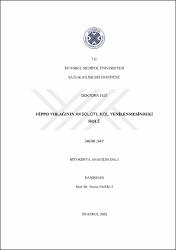| dc.contributor.advisor | Emekli, Neslin | |
| dc.contributor.author | Bay, Sadık | |
| dc.date.accessioned | 2021-09-21T07:02:59Z | |
| dc.date.available | 2021-09-21T07:02:59Z | |
| dc.date.issued | 2021 | en_US |
| dc.date.submitted | 2021 | |
| dc.identifier.citation | Bay, S. (2021). Hippo yolağının aksolotl kol yenilenmesindeki rolü. (Yayınlanmamış doktora tezi). İstanbul Medipol Üniversitesi Sağlık Bilimleri Enstitüsü, İstanbul. | en_US |
| dc.identifier.uri | https://hdl.handle.net/20.500.12511/8235 | |
| dc.description.abstract | Hippo yolağı farklılaşma, yenilenme, hücre göçü, organ büyümesi, apoptoz, hücre döngüsü gibi birçok hücresel olayda etkin rol oynamaktadır. Aksolotl canlılarda yenilenmeyi aydınlatmak için sık kullanılan bir modeldir. Bu çalışmada neotenik ve metamorfik aksolotlarda kol yenilenmesinde Hippo yolağında bulunan YAP ve LATS proteinlerinin durumu incelenmiştir. Çalışmada aksoltl kol yenilenmesinde metamorfik ve neotonik aksolotlarda kol hasarı yapılmış ve hasarın 10. gününde doku örnekleri toplanmıştır. Bu doku örneklerinde kantitatif gerçek zamanlı polimeraz zincir reaksiyonu (KGZ-PZR) ve immunohistokimya yapılmıştır. Gen inhibisyonu yapılan grupta ise, metamorfik ve neotonik hayvanlarda kol hasarının 10. gününde morfolino sistemi kullanılarak YAP ve LATS proteinlerinin inhibisyonu incelenmiştir. 6 gün beklenildikten sonra dokular izole edilip: KGZ-PZR, immunohistokimya ve proteomik çalışması ile sonuçlar değerlendirilmiştir. Kol hasarının 10. gününde, neotonik hayvanlarda YAP mRNA miktarı metamorfik hayvanlara göre 72 kat fazlayken, neotonik hayvanlarda LATS mRNA miktarı metamorfik hayvanlara göre 87 kat fazla olmuştur. Bu değerler hasarın 16. gününde neotonik hayvanlarda YAP mRNA miktarı metamorfik hayvanlara göre 227 kat fazlayken, neotonik hayvanlarda LATS mRNA miktarı metamorfik hayvanlara göre çok daha fazla artış (849 kat) göstermiştir. İnhibisyon yapılan metamorfik hayvanlarda, inhibisyon sonrası YAP ve LATS miktarları kontrol grubuna göre artmıştır. İnhibisyon yapılan neotonik hayvanlarda LATS inhibisyonu sonrası YAP ve LATS mRNA miktarları kontrol grubuna göre azalırken, YAP inhibisyonu sonrası YAP ve LATS mRNA miktarları kontrol grubuna göre artmıştır. İmmunohistokimya sonuçları ise pozitif hücreler sayılarak elde edilmiştir. Yenilenme tamamlanınca bilgisayarlı tomografi kullanılarak kemik fotoğrafları çekilmiştir. Proteomiks sonuçlarına göre neotonik hayvanda YAP inhibisyonu sonrası yara iyileşmesi proteinleri anlamlı artış göstermiştir. Sonuç olarak Hippo yolağı aksolotl kol yenilenmesinde elzem yolaklardan biri olmaya adaydır. Bu tez TÜBİTAK (1002 – 119Z976) tarafından desteklenmiştir. | en_US |
| dc.description.abstract | Axolotl is a unique model organism in terms of regeneration capacity. Considering the tasks of the Hippo pathway known in the literature, this pathway is expected to have an effective role in axolotl arm regeneration. Morpholino is mRNA inhibition system. It is one of the most frequently used techniques to illuminate regeneration in living things like axolotl. In this study, arm damage was performed for both metamorphic and neotenic axolotls. Tissue samples were collected on the 10th day after arm injury. Quantitative real-time Polymerase Chain Reaction (qRT-PCR) and immunohistochemistry were performed on these samples. In the gene-inhibited group, 10 days were waited after arm injury in metamorphic and neotenic animals, and inhibition of YAP and LATS proteins were performed on the 10th day using morpholino system. At 16 days after arm injury, tissues were isolated and qRT-PCR, immunohistochemistry and proteomics were performed. Yap decreased about 4 times and LATS decreased approximately 2 times in qRT-PCR analysis that shows the effectiveness of morpholino. On the 10th day after arm cut, while the amount of YAP mRNA in neotenic animals was 72 times higher than metamorphic animals; the amount of LATS mRNA in neotenic animals is 87 times higher than in metamorphic animals. These rates are on the 16th day; while the amount of YAP mRNA in neotenic animals was 227 times higher than metamorphic animals; the amount of LATS mRNA in neotenic animals is 849 times higher than in metamorphic animals. In inhibited neotenic animals, after LATS inhibition, the amount of YAP and LATS mRNA decreased compared to the control group. After YAP inhibition, the amount of YAP and LATS mRNA increased compared to control group. Immunohistochemistry results were obtained by counting positive cells. After the regeneration was completed, bones were visualized using computed tomography. According to proteomics results wound healing proteins after YAP inhibition showed significant increase in neotonic animal. As a result, Hippo pathway is essential pathway in axolotl arm regeneration. This thesis was supported by TUBITAK (1002 – 119Z976) | en_US |
| dc.language.iso | tur | en_US |
| dc.publisher | İstanbul Medipol Üniversitesi Sağlık Bilimleri Enstitüsü | en_US |
| dc.rights | info:eu-repo/semantics/openAccess | en_US |
| dc.subject | Aksolotl | en_US |
| dc.subject | Hippo Yolağı | en_US |
| dc.subject | Metamorfoz | en_US |
| dc.subject | Morfolino | en_US |
| dc.subject | Proteomiks | en_US |
| dc.subject | Hippo Pathway | en_US |
| dc.subject | Axolotl | en_US |
| dc.subject | Metamorphosis | en_US |
| dc.subject | Morpholino | en_US |
| dc.subject | Proteomics | en_US |
| dc.title | Hippo yolağının aksolotl kol yenilenmesindeki rolü | en_US |
| dc.title.alternative | The role of hi̇ppo pathway i̇n axolotl arm regenerati̇on | en_US |
| dc.type | doctoralThesis | en_US |
| dc.department | İstanbul Medipol Üniversitesi, Sağlık Bilimleri Enstitüsü, Biyokimya Ana Bilim Dalı | en_US |
| dc.relation.publicationcategory | Tez | en_US |


















